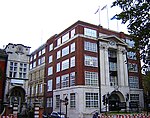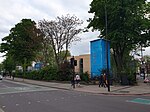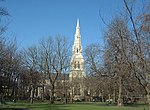Lakanal House fire
2009 disasters in the United Kingdom2009 fires2009 in London21st century in the London Borough of SouthwarkBuilding and structure fires in London ... and 5 more
CamberwellHigh-rise firesHistory of the London Borough of SouthwarkJuly 2009 events in the United KingdomResidential building fires
The Lakanal House fire occurred in a tower block on 3 July 2009 in Camberwell, London. Six people were killed, and at least twenty injured, when a high-rise fire, caused by a faulty television set, developed and spread through a number of flats in the twelve-storey building.
Excerpt from the Wikipedia article Lakanal House fire (License: CC BY-SA 3.0, Authors).Lakanal House fire
London Peckham (London Borough of Southwark)
Geographical coordinates (GPS) Address Nearby Places Show on map
Geographical coordinates (GPS)
| Latitude | Longitude |
|---|---|
| N 51.474880555556 ° | E -0.079872222222222 ° |
Address
SE5 7DF London, Peckham (London Borough of Southwark)
England, United Kingdom
Open on Google Maps







